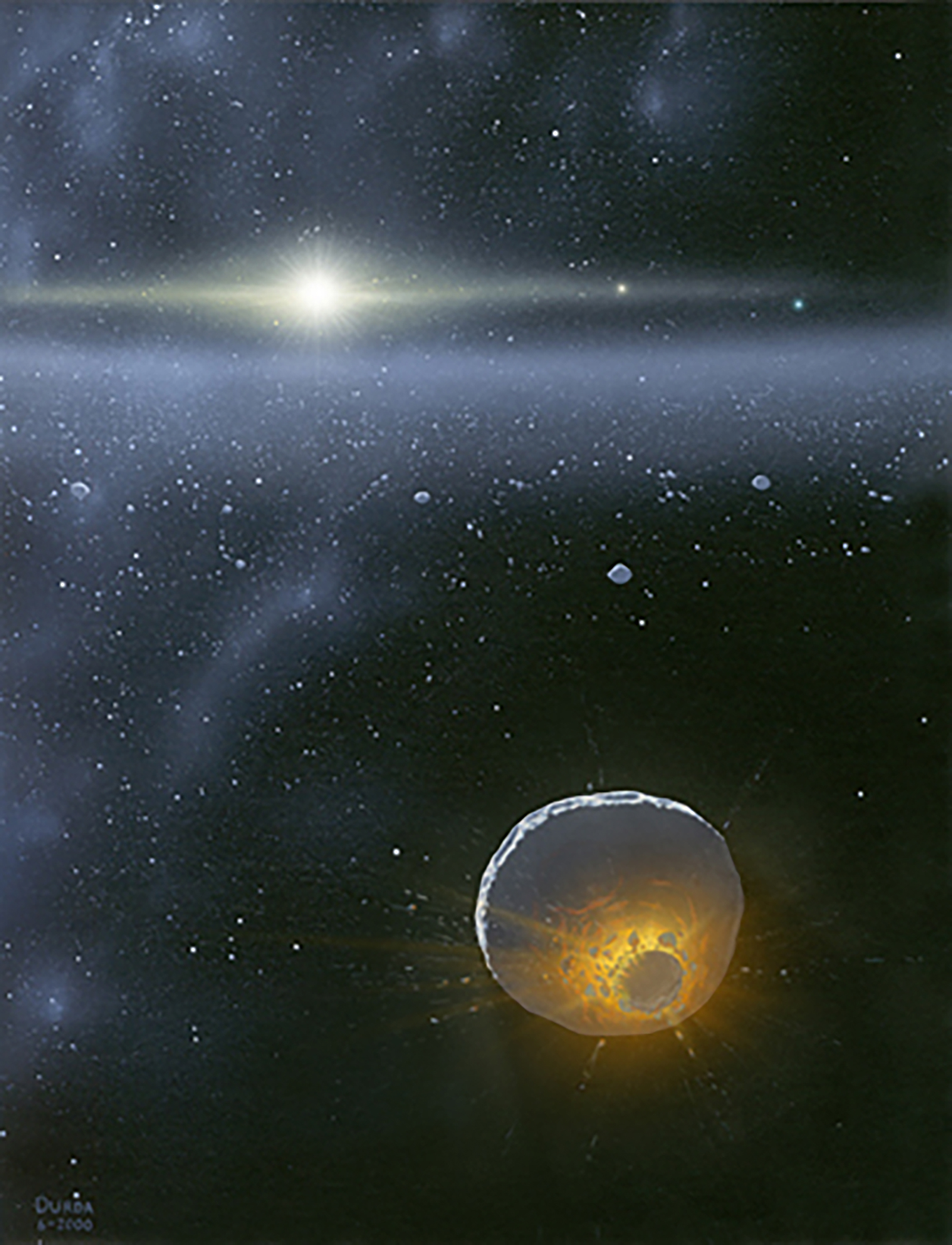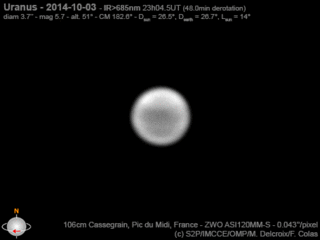New Horizons

What is New Horizons?
NASA's New Horizons spacecraft was the first spacecraft to explore Pluto up close, flying by the dwarf planet and its moons on July 14, 2015. In early 2019, New Horizons flew past its second major science target – Arrokoth (2014 MU69), the most distant object ever explored up close.
Nation | United States of America (USA) |
Objective(s) | Pluto Flyby, Kuiper Belt Object Flyby |
Spacecraft | New Horizons |
Spacecraft Mass | 1,054 pounds (478 kilograms) |
Power | |
Mission Design and Management | NASA / Johns Hopkins University Applied Physics Laboratory (APL) |
Launch Vehicle | Atlas V 551 (AV-010) |
Launch Date and Time | Jan. 19, 2006 / 19:00:00 UT |
Launch Site | Cape Canaveral, Fla. / Launch Complex 41 |
Scientific Instruments |
|
Firsts
- First spacecraft to explore Pluto and its moons up close.
- First spacecraft to explore a second Kuiper Belt Object up close – Arrokoth (2014 MU69)
Key Dates
Jan. 19, 2006: Launch
July 14, 2015: Pluto Flyby
Jan. 1, 2019: Arrokoth Flyby
Oct. 1, 2024: New Horizons passed 60 times as far from the Sun as Earth is, meaning the spacecraft is twice as far out as Pluto was when New Horizons flew by on July 14, 2015.
In Depth: New Horizons
New Horizons is a NASA mission to study the dwarf planet Pluto, its moons, and other objects in the Kuiper Belt, a region of the solar system that extends from about 30 AU, near the orbit of Neptune, to about 50 AU from the Sun.
It was the first mission in NASA’s New Frontiers program, a medium-class, competitively selected, and principal investigator-led series of missions. (The program also includes Juno and OSIRIS-REx.)
New Horizons was the first spacecraft to encounter Pluto, a relic from the formation of the solar system. By the time it reached the Pluto system, the spacecraft had traveled farther away and for a longer time period (more than nine years) than any previous deep space spacecraft ever launched.

The design of the spacecraft was based on a lineage traced back to the CONTOUR and TIMED spacecraft, both also built by the Applied Physics Laboratory at Johns Hopkins University.
Besides its suite of scientific instruments, New Horizons carries a cylindrical radioisotope thermoelectric generator (a spare from the Cassini mission) that provided about 250 watts of power at launch (decaying to 200 watts by the time of the Pluto encounter).
After reaching initial Earth orbit at about 105 × 130 miles (167 × 213 kilometers), the Centaur upper stage fired (for a second time) for nine minutes to boost the payload to an elliptical orbit that stretched to the asteroid belt.
A second firing of the Star 48B solid rocket accelerated the spacecraft to a velocity of about 36,400 miles per hour (58,536 kilometers per hour), the highest launch velocity attained by a human-made object relative to Earth. The spacecraft was now set on a trajectory to the outer reaches of the solar system.
Controllers implemented course corrections on Jan. 28, Jan. 30, and March 9, 2006. A month later, on April 7, 2006, New Horizons passed the orbit of Mars.
A fortuitous chance to test some of the spacecraft’s instruments – especially Ralph (the visible and infrared imager and spectrometer) – occurred June 13, 2006, when New Horizons passed by a tiny asteroid named 132524 APL at a range of about 63,300 miles (101,867 kilometers).
The spacecraft flew by the solar system’s largest planet, Jupiter, for a gravity assist maneuver on Feb. 28, 2007, with the closest approach at 05:43:40 UT. The encounter increased the spacecraft’s velocity by about 9,000 miles per hour (14,000 kilometers per hour), shortening its trip to Pluto by three years.
During the flyby, New Horizons carried out a detailed set of observations over a period of four months in early 2007. These observations were designed to gather new data on Jupiter’s atmosphere, ring system, and moons (building on research from Galileo) and to test out New Horizon’s instruments.
Although observing the moons from distances much farther than Galileo, New Horizons was still able to return impressive pictures of Io (including eruptions on its surface), Europa, and Ganymede.
After the Jupiter encounter, New Horizons sped toward the Kuiper Belt, performing a course correction on Sept. 25, 2007.
The spacecraft was put in hibernation mode starting June 28, 2007, during which time the spacecraft’s onboard computer kept tabs on mission systems, transmitting special codes indicating that operations were either nominal or anomalous. During hibernation, most major systems of New Horizons were deactivated and revived only about two months every year. The second, third, and fourth hibernation cycles were Dec. 16, 2008, Aug. 27, 2009, and Aug. 29, 2014.
New Horizons passed the halfway point to Pluto on Feb. 25, 2010.
The discovery of new Pluto moons Kerberos and Styx during the mission added to concerns that there might be debris or dust around Pluto. Mission planners devised two possible contingency plans in case debris increased as the spacecraft approached Pluto, either using its antenna facing the incoming particles as a shield or flying closer to Pluto where there might be less debris.
On Dec. 6, 2014, ground controllers revived New Horizons from hibernation for the last time to initiate its active encounter with Pluto. At that time, it took four hours and 25 minutes for a signal to reach Earth from the spacecraft.
The spacecraft began its approach phase toward Pluto on Jan. 15, 2015, and its trajectory was adjusted with a 93-second thruster burn on March 10. Two days later, with about four months remaining before its close encounter, New Horizons finally became closer to Pluto than Earth is to the Sun.
Pictures of Pluto began to reveal distinct features by April 29, 2015, with detail increasing week by week into the approach. A final 23-second engine burn on June 29, 2015, accelerated New Horizons toward its target by about 11 inches per second (27 centimeters per second) and fine-tuned its trajectory.
There was concern on July 4, 2015, when New Horizons entered safe mode due to a timing flaw in the spacecraft command sequence. Fortunately, the spacecraft returned to normal science operations by July 7.
Three days later, data from New Horizons was used to conclusively answer one of the most basic mysteries about Pluto: its size. Mission scientists concluded that Pluto is about 1,470 miles (2,370 kilometers) in diameter, slightly larger than prior estimates. Its moon Charon was confirmed to be about 750 miles (1,208 kilometers) in diameter.

Finally, at 11:49 UT on July 14, 2015, New Horizons flew about 4,800 miles (7,800 kilometers) above the surface of Pluto. About 13 hours later, at 00:53 UT on July 15, a 15-minute series of status messages was received at mission operations at Johns Hopkins University’s APL (via NASA’s Deep Space Network) confirming that the flyby had been fully successful.
Besides collecting data on Pluto and Charon (the Charon flyby was at about 17,900 miles or 28,800 kilometers), New Horizons also observed Pluto’s other satellites, Nix, Hydra, Kerberos, and Styx.
The download of the entire set of data collected during the encounter with Pluto and Charon – about 6.25 gigabytes – took over 15 months and was officially completed at 21:48 UT on Oct. 25, 2016. Such a lengthy period was necessary because the spacecraft was roughly 4.5 light-hours from Earth and it could only transmit 1-2 kilobits per second.
Data from New Horizons clearly indicated that Pluto and its satellites were far more complex than imagined, and scientists were particularly surprised by the degree of current activity on Pluto’s surface. The atmospheric haze and lower than predicted atmospheric escape rate forced scientists to fundamentally revise earlier models of the system.
Pluto, in fact, displays evidence of vast changes in atmospheric pressure and possibly had running or standing liquid volatiles on its surface in the past. There are hints that Pluto could have an internal water-ice ocean today.
Stunning photographs showed a vast heart-shaped nitrogen glacier (named Sputnik Planitia for Sputnik 1, Earth’s first artificial satellite) on the surface. It’s about 600 miles wide (1,000 kilometers), undoubtedly the largest known glacier in the solar system.
On Charon, images showed an enormous equatorial extension tectonic belt, suggesting a long-past water-ice ocean.
In the fall of 2015, after its Pluto encounter, mission planners began to redirect New Horizons for a Jan. 1, 2019, flyby of 2014 MU69, a Kuiper Belt Object that is approximately 4 billion miles (6.4 billion kilometers) from Earth. The object was later officially named Arrokoth.
Four course corrections were implemented in the fall while a fifth was carried out on Feb. 1, 2017. The goal of the encounter was to study the surface geology of the object, measure surface temperature, map the surface, search for signs of activity, measure its mass, and detect any satellites or rings.
On April 3, 2017, the spacecraft was halfway from Pluto to its new target. Soon after, on April 10, New Horizons entered hibernation mode, when much of the vehicle remained in an unpowered mode for “a long summer’s nap” that lasted until Sept. 11, 2017. During that time, the flight computer broadcast a weekly beacon-status tone back to Earth, and another data stream once a month on spacecraft health and safety data.
On the anniversary of its Pluto-Charon flyby, July 14, 2017, the New Horizons team unveiled new detailed maps of both planetary bodies.
On Jan. 1, 2019, New Horizons flew past Arrokoth, the most distant target in history.
Initial images hinted at a reddish, snowman-like shape, but further analysis of images taken near the closest approach – New Horizons came to within just 2,200 miles (3,500 kilometers) – revealed just how unusual the KBO’s shape really is.

End to end, the overall shape of Arrokoth measures about 22 miles (35 kilometers) long. It’s about 12 miles (20 kilometers) wide, by 6 miles (10 kilometers) thick. The larger lobe was found to be "lenticular," which means it's flattened and shaped like two lenses placed back to back. It has dimensions of approximately 14 × 12 × 4 miles (22 × 20 × 7 kilometers). The smaller lobe is more rounded and is approximately 9 × 9 × 6 miles (14 × 14 × 10 kilometers) in its dimensions.
“We’ve never seen anything like this anywhere in the solar system,” said Principal Investigator Dr. Alan Stern, of the Southwest Research Institute in Boulder, Colorado. “It is sending the planetary science community back to the drawing board to understand how planetesimals – the building blocks of the planets – form.”
According to Dr. Stern, the New Horizons spacecraft remains healthy deep in the Kuiper Belt, and it is speeding away from the Earth and Sun at a rate of about 300 million miles per year. The spacecraft was put into hibernation mode on June 1, 2022, and will remain in hibernation until March 1, 2023, to save fuel, and wear and tear on the spacecraft.
In April 2022 its mission was extended a second time to potentially conduct multi-disciplinary observations of relevance to the solar system and NASA’s Heliophysics and Astrophysics Divisions.
Key Source
Siddiqi, Asif A. Beyond Earth: A Chronicle of Deep Space Exploration, 1958-2016. NASA History Program Office, 2018.












